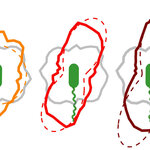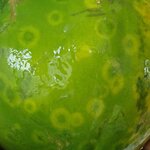Microbiology

Aggressive marketing by raw milk proponents has included claims that raw milk is easier to stomach for for lactose-intolerant people but a pilot study from the Stanford University School of Medicine shows no meaningful difference in digestibility between raw and pasteurized milk.
The study was small — 16 participants — but highly consistent among all and deflate some of the beneficial claims surrounding raw, or unpasteurized, milk. Relatively few people drink raw milk — it's thought to comprise less than 1 percent of milk consumed nationwide — but its share of foodborne illnesses is…

We tend to think of antibiotic resistance as a product of modern medicine and the mutation ability of pesky viruses to get around dying.
Writing in the journal Applied and Environmental Microbiology, a team of investigators say they have discovered viruses containing genes for antibiotic resistance in a fossilized fecal sample from 14th century Belgium, long before antibiotics were used in medicine.
The viruses in the fecal sample are phages, which are viruses that infect bacteria, rather than infecting eukaryotic organisms such as animals, plants, and fungi. Most of the viral…

A new study finds that bacterial movement is impeded in flowing water, enhancing the likelihood that the microbes will attach to surfaces, which sheds some new light on how infections take hold in medical devices.
The findings were the result of microscopic analysis of bacteria inside microfluidic devices and combined experimental observations with mathematical modeling. The study showed that the flow of liquid can have two significant effects on microbes: “It quenches the ability of microbes to chase food,” says co-author Roman Stocker, an assitant professor of civil engineering at MIT…

Would avant-garde musician be offended that scientists named a zit-causing bacterium P. acnes type Zappae.
No, he would probably laugh.
But to winemakers it's not all that funny, it's instead a striking case of pathogen transfer. Campisano, et. al., report in the journal Molecular Biology and Evolution about a new type of P. acnes which exploits grapevines. P. acnes type Zappae got the naming nod with multicultural layers. In Italian Zappa means "hoe" and he once wrote of "sand-blasted zits" in his song "Jewish Princess" on the "Sheik Yerbouti "album. The 1970s saw a lot of people…

As if pretty people didn't have enough advantages, they may also give us a glance at their reproductive health, according to a paper in the American Journal of Human Biology reveals a link between Body Mass Index (BMI) and the amount of bacteria colonizing noses.
The results show that heavier men harbor more potentially pathogenic species of bacteria in their nose, compared with slimmer, more traditionally attractive men.
"According to an evolutionary point of view, traits related to attractiveness are supposed to be honest signals of biological quality," according to lead author Dr.…

Researchers have discovered the genetic machinery that turns the common gut bacterium Bacteroides ovatus
into the Swiss Army knife of the digestive tract, helping us metabolize a main component of dietary fiber from the cell walls of fruits and vegetables.
The findings illuminate the specialized roles played by key members of the vast microbial community living in the human gut, and could inform the development of tailored microbiota transplants to improve intestinal health after antibiotic use or illness.
About 92 percent of the population harbors bacteria with a variant of…

Mexico is considered one of the leading countries in papaya production but its crops are affected by the virus of the ringed spot, which leaves ring marks in the skin of the fruit and causes softening of the papaya, where fungi start to digest it.
More than 80 per cent of the production is exported to the United States and, according to the Mexican Association Industry of Plant Sanitation (AMIFAC), Europe and Asia are possible markets for 2014, so the fruit has to comply with sanitation laws of other countries, being free of microorganisms, and having the right appearance (no spots,…

Want yogurt but don't like the exploitation of dairy cows?
Researchers at the Universitat Politècnica de València have some good news. They have used plant-based “milks” to create products fermented with probiotic bacteria from grains and nuts - an alternative to conventional yogurts. They say the products are ideal for people with allergies to cow milk, lactose or gluten intolerance.
From the laboratories at the Institute of Food Engineering for Development, the team has worked with almonds, oats and hazelnuts as raw material for these new products. Their in vitro studies show how…

Some bacteria achieve resistance to antibiotics through mutation but other types of bacteria, known as 'persistent' bacteria, are not resistant to the antibiotics but simply continue to exist in a dormant or inactive state while exposed to antibacterial treatment.
These bacteria later 'awaken' when that treatment is over, resuming their work.
It was known that there is a connection between these kind of bacteria and the naturally occurring toxin HipA in the bacteria, but scientists did not know the cellular target of this toxin and how its activity triggers dormancy of the bacteria.…
In a new paper, a team reports their recent work examining the effects of spaceflight on microbial pathogens - in this case infectious disease potential of the fungal pathogen, Candida albicans, the first global gene expression profiling and phenotypic characterization of a fungal pathogen during spaceflight.
Candida is a type of fungus—a eukaryotic microorganism. It is often found in soils and water and is ubiquitous in man-made environments, including the space shuttle and International Space Station. C. albicans is part of the normal flora of human beings, present on the skin,…